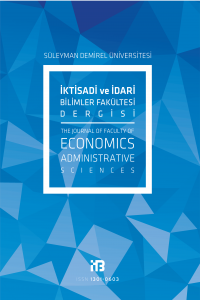OECD ÜLKELERİNDE SAĞLIĞIN YAKINSAMASININ ANALİZİ: PANEL BİRİM KÖK TESTİ
Sağlık, yakınsama, panel birim kök testi, CIPS testi
OECD Ülkelerinde Sağlığın Yakınsamasının Analizi: Panel Birim Kök Testi
Health, convergence, panel unit root test, CIPS test,
___
- ABRAMOVITZ, M. and P. A. David (1996), “Convergence and Deferred Catch-Up: Productivity Leadership and the Waning of American Exceptionalism”, Edt: R. Landau, T. Taylor ve G. Wright, The Mosaic of Economic Growth, Standford: Standford University Press, 21- 62.
- ALCALDE- UNZU, J., R. Ezcurra, R. ve P. Pascual (2009), “Cross- Country Disparities in Health Care Expenditure: A Factor Decomposition”, Health Economics, 18, 479-485.
- ASLAN, A. (2009), “Convergence of Per Capita Health Care Expenditures in OeCD Countries”, International Research Journal of Finance and Economics, 24, 48-53.
- BANKAUSKAITE, V. and J. S. O’Connor (2008), “Health Policy in the Baltic Countries Since the Beginning of the 1990s”, Health Policy, 88, 155-165.
- BARRO, R.J. (1996), “Health and Economic Growth”, Senior Policy on Health, Human Capital and Economic Growth: Theory, Evidence and Policies, Pan American Health Organization and Inter-American Development Bank, Washington, DC.
- BARROS, P.P. (1998), “The Black Box of Health Care Expenditure Growth Determinansts”, Health Economics, 7, 533-544.
- BLOOM, D., D. Canning and J. Sevilla (2001), “The Effect of Health on Economic Growth Theory and Evidence”, NBER Working Paper, 1-26.
- CHOU, W. L. and Z. Wang (2009), “Regional Inequality in China’s Health Care Expenditures”, Health Economics, 18 (2), 137-146.
- CLARK, R. (2011), “World Health Inequality: Convergence, Divergence, and Development”, Social Science and Medicine, 72, 617- 624.
- EHRLICH, I. and T. F. Lui (1991), “International Trafe, Longevity and Economic Growth”, Journal of Political Economy, 99, 1029-1059.
- GACHTER, M. and E. Theurl (2011), “ Health Status Convergence at The Local Lavel: Empirical Evidence from Austria”, International Journal for Equity in Health, 10, 1-14
- GYIMAH, B. and M. Wilson (2004), “Health Human Capital and Economic Growth in Sub-Saharan African and OECD Countries”, The Quarterly Review of Economics and Finance, 44 (2), 296-320.
- HITIRIS, T. (1997), “Health Care Expenditures and Integration in the Countries of European Union”, Applied Economics, 29 (1), 1-6.
- HITIRIS, T. and J. Nixon (2001), “Convergence of Health Care expenditures in The EU Countries”, Applied Economics Letters, 8 (4), 223-228.
- JONES, B. (2002), “Economic Integration and Convergence of Per- Capita Income in West Africa”, African Development Review, 14(1), 18– 47.
- KEREM, K., T. Püss, M. Viies and R. Maldre (2008), “Health and Convergence of Health Expenditures in EU”, International Business Economics Research Journal, 7 (3), 29-44.
- LEITER, M.A and E. Theurl (2012), “The Convergence of Health Care Financing Structures: Empirical Evidence from OECD Countries”, European Journal Health Economics, 13, 7-18.
- LIARGOVAS, P.G and G. Fotopoulos (2009), “Socioeconomic Indicators for Analyzing Convergence: The Case of Greece: 1960-2004”, Springer, 93 (2), 315-330
- MACKENBACH, J.P. (2012), “Convergence and Divergence of Life Expectancy in Europe: A Centennial View”, European Journal Epidemiology, 1-13.
- MCDONALD, C.S and J. Roberts (2002), “Growth and Multiple Forms of Human Capital in An Augmented Solow Model: A Panel Data”, Economic Letters, 74, 271-276.
- MELTZER, D. (1995), “Mortality Decline, the Demographic Transition and Economic Growth”, Mimeo Universiy of Chicago, 1-21.
- MINCER, J. (1996), “Economic Development, Growth of Human Capital and The Dynamics of The Wage Structure”, Journal of Economic Growth, 1 (1), 29-48.
- MONTERO-GRANADOS, R., J. Jimenez and J. Martin (2007), “Decentraalisation and Convergence in Health Among the Provinces of Spain (1980-2001)”, Social Science Medicine, 64, 1253-1264.
- NARAYAN, P.K. (2007), “Do health Expenditures “Catch-Up”? Evidence From OECD Countries”, Health Economics, 16 (10), 993- 1008.
- NIXON, J. (2000), “Convergence of Health Care Spending and Health Outcomes in the European Union, 1960-95”, Discussion Paper, 183, 1- 27.
- PAAS, T., A. Kuusk, F. Schlitte and A. Vörk (2007), “Econometric Analysis of Income Convergence in Selected EU Countries and Their Nuts III Regions”, Working Paper , No: 60-2007.
- PANOPOULOU, E. and T. Pantelidis (2012), “Convergence in Per Capita Health Expenditures and Health Outcomes in the OECD Countries”, Applied Economics, 44 (30), 3909-3920.
- PESERAN, H. (2004), “General Diagnostic Tests for Cross Section Dependence in Panels, University of Cambridge”, Working Paper, 0435.
- PESERAN, M.H. (2007), “A Simple Panel Unit Root Test in The Presence of Cross-Section Dependence”, Journal of Applied Econometrics, 22, 265-312.
- RASSEKH, F. (1998), “The Convergence Hypothesis: History, Theory, and Evidence”, Open Economics Review, 9, 85-105.
- SCHULTZ, T. (1971), Investment In Capital, The Role of Education and of Research, The Free Pres A Division of The Macmillan Company, NewYork.
- SCHULTZ, T. (1993), “Human Capital, Schooling and Health Returns”, Center Discussion Paper, No: 853, 1-22.
- SUB-SMITH, S. (2001), “Human Capital Convergence: International Evidence”, IMF Working Paper.
- UMUTLU, G., F. A. Yılmaz ve S. Günel (2011), “Ekonomik Büyüme Farklılıklarının İncelenmesi: OECD Ülkeleri İçin Bir Uygulama”, SÜ İİBF Sosyal ve Ekonomik Araştırmalar Dergisi, 16 (22), Konya, 351- 372.
- WANG, Z. (2009), “The Convergence of Health Care Expenditures in The US States”, Health Economics, 18, 55-70.
- WENDT, C., S. Grimmeisen, U. Helmert, H. Rothgang, and M. Cacace (2004), “Convergence or Divergence of OECD Health Caree Systemys”, Transtate Working Paper, No: 9, 1-36.
- ISSN: 1301-0603
- Yayın Aralığı: Yılda 3 Sayı
- Başlangıç: 1996
- Yayıncı: Süleyman Demirel Üniversitesi
OECD ÜLKELERİNDE SAĞLIĞIN YAKINSAMASININ ANALİZİ: PANEL BİRİM KÖK TESTİ
Yrd.Doç.Dr.Sevinç YARAŞIR TÜLÜMCE, Yrd.Doç.Dr.Fatma ZEREN
Öğr.Gör.Ferhat BİTLİSLİ, Okt.mehmet DİNÇ, Öğr.gör.esra ÇETİNCELİ, Yrd.doç.dr.ümmühan KAYGISIZ
ÖRGÜTSEL ADALET ALGILAMALARININ İŞ TATMİNİNE ETKİSİ: HASTANE ÇALIŞANLARI ÜZERİNDE BİR ARAŞTIRMA
Yrd.Doç.Dr.Belma KEKLİK, Uz.Nurcan COŞKUN US
Dr.ibrahim Yaşar GÖK, Prof.dr.şeref KALAYCI
İNŞAAT SÖZLEŞMELERİNDE ZARARIN MUHASEBELEŞTİRİLMESİ VE RAPORLANMASI
MODERN ARNAVUTLUK'TA DEMOKRASİ, İSLAM VE SİYASET
Yrd.Doç.Dr.Bekir ÇINAR, Mrs.elisa GONZALEZ
ÖZERK YEREL YÖNETİMLERİN OLUŞUMUNDA KENTLERİN TARİHSEL İŞLEVİ -Almanya Temelinde Bir Yaklaşım-
BULANIK DOĞRUSAL PROGRAMLAMA İLE SÜT ENDÜSTRİSİNDE BİR UYGULAMA
